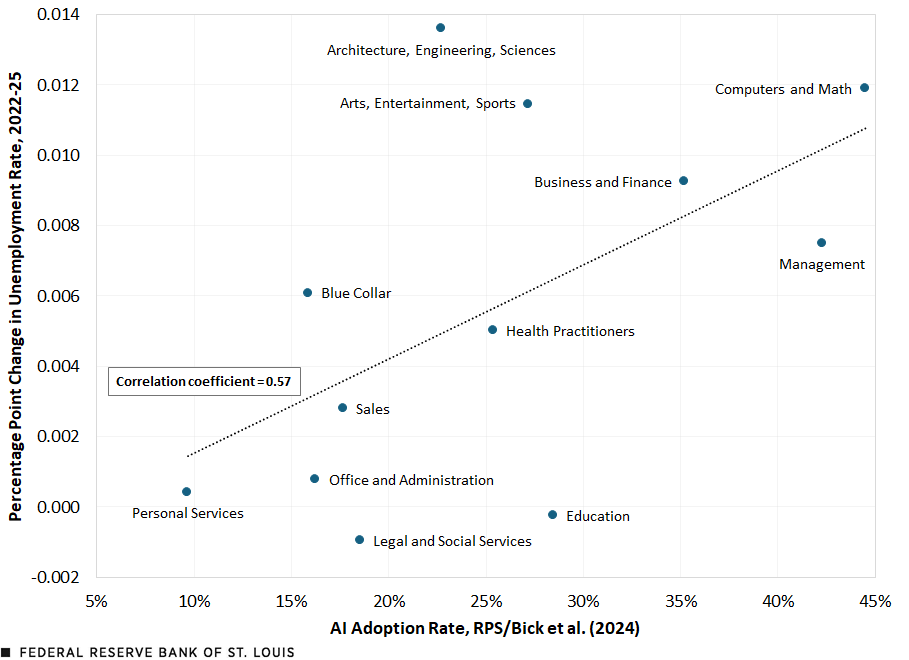Is AI Contributing to Rising Unemployment? Evidence from Occupational Variation
The July jobs report showed a sharp deceleration in payroll growth with an average of just 35,000 jobs per month from May through July—well below previous years’ robust gains. The unemployment rate rose to 4.2%, marking a meaningful shift from stronger prepandemic conditions; unemployment averaged 3.7% in 2019.
While economists debate various causes for the labor market softening, one potential factor deserves closer scrutiny: the rapid adoption of artificial intelligence (AI) tools in the workplace. Could widespread deployment of large language models (LLMs) like ChatGPT, Claude and others be contributing to rising unemployment?
Rapid AI Adoption in the Workplace
By early 2023, generative AI had become ubiquitous across the American workforce. ChatGPT and similar tools were integrated into browsers, office software and search engines, making LLM use routine for millions of workers. According to the nationally representative Real-Time Population Survey (RPS),The RPS asks the same core questions and follows the same timing and structure as the Current Population Survey (CPS), the monthly labor force survey conducted by the U.S. Census Bureau for the Bureau of Labor Statistics. 23% of employed workers used generative AI for work at least once per week as of late 2024—a remarkable adoption rate for such a nascent technology.See Alexander Bick, Adam Blandin and David J. Deming’s Federal Reserve Bank of St. Louis Working Paper 2024-027E, “The Rapid Adoption of Generative AI.” Despite this widespread integration, we still know surprisingly little about AI’s employment effects because of the newness of the technology.
Measuring AI’s Impact: Two Complementary Approaches
We use two distinct measures of AI’s prevalence across occupations to investigate whether AI adoption correlates with rising unemployment:
- Theoretical AI Exposure: We used groundbreaking work published last year that employed both human annotators and OpenAI’s GPT-4 model itself to assess whether LLMs could reduce task completion time by at least 50%.See Tyna Eloundou, Sam Manning, Pamela Mishkin and Daniel Rock’s June 2024 article, “GPTs Are GPTs: Labor Market Impact Potential of LLMs,” in Science. The researchers applied this methodology to 19,265 tasks from the U.S. Department of Labor’s O*NET database, then aggregated results at the occupational level to create comprehensive AI exposure scores.
- Actual AI Adoption: We examined real-world uptake patterns from the RPS, in which workers reported the intensity of their actual generative AI usage and time savings. This approach captures not just theoretical potential but genuine workplace integration.
AI and Unemployment
Both measures reveal a striking correlation between AI’s prevalence and unemployment increases since 2022.
The figure below shows that occupations with higher AI exposure experienced larger unemployment rate increases between 2022 and 2025, with a 0.47 correlation coefficient. We measured the percentage point change in unemployment using the three-month average unemployment rates for May through July in 2022 and 2025 to smooth out monthly volatility and control for seasonality in the data. Computer and mathematical occupations—predictably among the most AI-exposed, with a score around 80%—saw some of the steepest unemployment rises. Meanwhile, blue-collar jobs and personal service roles, which have limited AI applicability, experienced relatively smaller increases.
AI Exposure and Change in Unemployment across Occupations

SOURCES: Eloundou et al. (2024), Current Population Survey, Bureau of Labor Statistics and authors’ calculations.
NOTES: This figure plots occupations’ 2022-25 change in unemployment rate versus their AI exposure rate. AI exposure rate is derived from ChatGPT-β predicted exposure via Eloundou et al. (2024). The unemployment rates are the three-month averages for May through July in 2022 and 2025.
The following figure uses actual adoption data that reinforce this pattern. Occupations that embraced generative AI most intensively showed the largest unemployment gains, with a correlation coefficient of 0.57. Again, computer and mathematical occupations, which adopted these technologies most heavily, experienced substantial unemployment increases.
AI Adoption and Change in Unemployment across Occupations

SOURCES: RPS, Current Population Survey, Bureau of Labor Statistics and authors’ calculations.
NOTES: This figure plots occupations’ 2022-25 change in unemployment rate versus their AI adoption rate. AI adoption rate is derived from the RPS. The unemployment rates are the three-month averages for May through July in 2022 and 2025.
Why This Matters
These patterns are particularly striking in technology sectors, where workers might expect AI to augment rather than to replace their roles. Software developers, data analysts and other tech professionals are finding that AI tools can indeed accelerate certain tasks, but potentially at the cost of overall employment demand.
Our results suggest we may be witnessing the early stages of AI-driven job displacement. Unlike previous technological revolutions that primarily affected manufacturing or routine clerical work, generative AI can target cognitive tasks performed by knowledge workers—traditionally among the most secure employment categories.
Limitations and Future Research
The findings presented here represent correlation, not causation. Multiple factors could explain rising unemployment in AI-exposed occupations, including economic uncertainty, postpandemic monetary policy tightening and chance timing. Furthermore, this analysis is based on preliminary findings in a rapidly evolving field. However, the consistency across both theoretical exposure and actual adoption measures suggests the relationship may be more than coincidental.
Additionally, the technology is so new that longer-term effects remain unknown. If generative AI drives sustained productivity growth, it could ultimately create new jobs and industries, potentially offsetting displacement effects. As AI capabilities continue advancing rapidly, monitoring these employment patterns becomes increasingly critical.
Looking Ahead
The data raise important questions about our economic transition into the AI era. If current trends continue, new approaches to workforce development, social safety nets and economic support for displaced workers may merit greater consideration. As we navigate this technological revolution, understanding potential early warning signs could prove crucial for protecting U.S. workers and maintaining economic stability.
Notes
- The RPS asks the same core questions and follows the same timing and structure as the Current Population Survey (CPS), the monthly labor force survey conducted by the U.S. Census Bureau for the Bureau of Labor Statistics.
- See Alexander Bick, Adam Blandin and David J. Deming’s Federal Reserve Bank of St. Louis Working Paper 2024-027E, “The Rapid Adoption of Generative AI.”
- See Tyna Eloundou, Sam Manning, Pamela Mishkin and Daniel Rock’s June 2024 article, “GPTs Are GPTs: Labor Market Impact Potential of LLMs,” in Science.
Citation
Serdar Ozkan and Nicholas Sullivan, ldquoIs AI Contributing to Rising Unemployment? Evidence from Occupational Variation,rdquo St. Louis Fed On the Economy, Aug. 26, 2025.
This blog offers commentary, analysis and data from our economists and experts. Views expressed are not necessarily those of the St. Louis Fed or Federal Reserve System.
Email Us
All other blog-related questions



